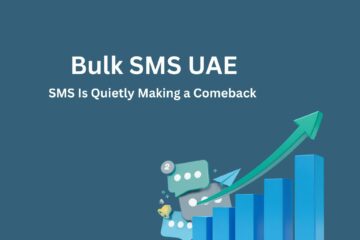
When a company in São Paulo sent a flash-sale alert to 10,000 customers, they discovered that their choice of SMS vendor dramatically influenced how many messages they could afford. That kind of real-life cost awareness underlines why this article on bulk SMS price in Brazil matters — we’ll walk you through everything you need to know, from basic per-message rates to settlement of campaign budget, international comparison, and how a global provider like SMSala simplifies messaging at scale. This isn’t just theory — it’s cost-smart guidance.
Understanding Bulk SMS Price: What’s Included?
It is worth mentioning before getting down to the specific figures on Brazil that bulk SMS price is what we are talking about and what influences it.
- Bulk SMS refers to mass text-messages that are sent at once (in batches) usually thousands or tens of thousands of messages, usually in marketing, notifications.
- The price per message is influenced by destination country (here Brazil), carrier network, message type (promotional vs transactional), message-length (segments), and volume (discounts for large volumes).
- By way of illustration, a 160 character message will only be 1 segment; the more you send, or the more you use Unicode characters, the more you can send and the more it will cost. Tools like the SMS length & pricing calculator show this clearly.
- In Brazil you might also see local currency (BRL) or USD/Euro‐converted pricing, and each vendor may treat “bulk” differently (e.g., 10,000 messages vs 100,000 messages).
- Because of these variables, when someone asks “What’s the bulk SMS price in Brazil?” there’s no single figure — there’s a range, and the devil is in the details of message count, network, vendor route and campaign type.
So keep in mind: the quoted per-message rate is a headline, but your real cost depends on volume, segmentation, campaign type and vendor route. With that in mind, let’s look at real numbers for Brazil in 2025.
Current Rates in Brazil: Real-World Data
The following are just some confirmed rates of per-message in Brazil, which can act as a benchmark of what you may actually pay.
- One of them offers Brazil rates of US$0.0254 per message (transaction and promotion) with such major carriers as Vivo, TIM, Claro, Oi.
- Another source lists per-message cost for Brazil at €0.035 and above (for all recognized carriers) depending on route.
- A globally-oriented provider lists a Brazil per-SMS cost as low as €0.0109 for certain volumes/routes.
- One platform quotes Brazil at roughly $0.03 USD per message.
- For example: one vendor put 10,000 credits for Brazil at US$335, working out to about US$0.0335 per message (≈3.35 c).
- A Brazil vendor lists direct route price as R$ 0.06 (Brazilian Real) per segment.
So what does this tell us?
In Brazil, in 2025, you would be approximately in the ball-park of between US$0.02-US$0.04 per message, depending on route, volume and segmentation. Converting to Brazilian Real (BRL) and local currency fluctuations will also matter.
Because of volume discounts and negotiated deals, prices can drop further if you send large volumes. It’s safe to budget for maybe US$0.025 (≈R$ 0.13-0.14 depending on currency) per message for moderate volumes, and then aim to negotiate lower for high-volume campaigns.
Why Rates Vary: Key Cost Drivers
Understanding the cost drivers helps you estimate your own bulk SMS price more accurately and avoid surprises.
a) Message segments & characters
If you use accents (common in Portuguese), Unicode, or exceed 160 characters, your message may split into 2-3 segments — doubling or tripling the cost. Example: Brazilian Portuguese special characters may trigger Unicode encoding.
Thus your “per message” price might effectively become “per segment” price.
b) Destination carrier / route quality
Brazil has multiple carriers (Vivo, TIM, Claro, Oi) and some vendors route via less-direct paths, which may increase cost or impact deliverability. One vendor lists uniform cost across major carriers in Brazil at US$0.0254.
Higher quality direct-routes may cost more — so cheaper isn’t always better if delivery suffers.
c) Volume / discounts
As with many services, higher volume = lower cost per unit. For example: a vendor gives per-SMS rates starting €0.0109 if you send large volumes.
If you only send a small campaign, expect less favourable pricing.
d) Message type: promotional vs transactional
Some markets differentiate between promotional (marketing) messages and transactional (alerts, OTPs). Brazil vendors may offer different pricing tiers. For example, the US$0.0254 figure covers both transactional & promotional in the same table.
If you’re sending marketing blasts vs critical alerts, ask the vendor which rate applies.
e) Currency & tax / regulatory overhead
If you’re billed in USD or EUR but delivering to Brazil, the exchange rate or local tax may affect your effective cost. Also regulatory compliance (sender ID registration, opt-out management) may add cost.
For example “sms em massa preço” (Portuguese for “bulk SMS price”) may include local taxes/regulations.
By being aware of these drivers, you can better evaluate vendor quotes and avoid hidden surprises.
Benchmarking Your Budget: Sample Scenarios
Let’s walk through two simple budget-scenarios to show how bulk SMS price plays out in practice.
Scenario A: Small campaign
It is assumed that the company would like to send 5,000 SMS messages in Brazil, promotion campaign (Portuguese), average length uses 1 segment, you select a medium-priced supplier with US 0.03/message (or approximately R 0.15/message).
Cost = 5,000 × US$0.03 = US$150 (≈R$ 750)
Then factor in setup, opt-out management, any list-cleanup cost — maybe add ~10%.
So budget about US$165 (~R$ 825) for this campaign.
Scenario B: High-volume enterprise campaign
Your brand is planned to conduct 250,000 messages in Brazil, mixed marketing + alert, vendor offers discounted rate US$0.02 per message (≈R$ 0.10).
Cost = 250,000 × US$0.02 = US$5,000 (≈R$ 25,000)
You can bargain on additional discounts (e.g.US -0.018 per message) in case you guarantee delivery volume + time-window.
The segmentation, dynamic content, analytics/reporting are also available as costs, which might increase by an estimated 5-10%.
Hence a budget of around US 5-800 (around R 27-29,000) to do the entire campaign.
These sample scenarios illustrate how the bulk SMS price influences your budget and how scaling drives per-message savings.
If you’re using a global messaging platform like SMSala, their scale and operator connections help simplify global reach while optimizing cost — meaning your Brazil cost is just one piece of a global campaign plan and you benefit from their global pricing leverage.
How to Select a Vendor & Negotiate Better Rates
When comparing vendors for your Brazil campaign (and globally), focus on the following checklist to get the most value from your bulk SMS price:
- Ask for a Brazilian-specific rate card: Make sure the vendor quotes Brazil (BR) per message, not a generic “Worldwide” average.
- Check how they count segments: Clarify whether their quoted rate is per message or per segment; confirm 160-character GSM vs Unicode behavior.
- Check carrier/route quality: Ask them whether they use direct-routes to the major Brazilian carriers (Vivo, TIM, Claro, Oi) bad routing may contribute to hidden costs (e.g., retries, failed deliveries).
- Volume level prices: Requested tiered pricing- 0-10,000 messages- US$0.03, 10,001-50,000 messages- US$0.025 and 50,000 and above- US$0.02. Use your campaign plan to estimate the discount threshold. For example one vendor lists €0.0092 for large volumes in Brazil.
- Transparency on extra fees: Fees for sender ID registration, opt-out handling, unicode characters, or failed deliveries should be clear.
- Look for support and reporting: A vendor like SMSala offers global scale, analytics and integration, which may cost more per message but save time, errors, and hidden operational cost.
- Negotiate multiple country bundling: When you intend to run campaigns in Latin America, as well as the US and Europe, you can bundle volumes in various regions to achieve a lower actual cost of running programs in Brazil.
With this checklist, you check that you have a reasonable quote price on bulk SMS and will not be caught in the dark by any miscellaneous charges or ineffective delivery.
Global Comparison: How Brazil Rates Stack Up
It helps to compare Brazil with other markets to understand if your Brazil rate is competitive.
- According to one pricing table, Brazil is listed at ~US$0.03 per message.
- Many countries in Europe/Asia have rates below US$0.02.
- Some providers list Brazil at €0.0109 (~US$0.012) for high volume.
- Other sources have Brazil at US$0.0254 uniformly.
So your Brazil bulk-SMS cost should typically land somewhere in the middle of the global range — not the absolute cheapest, but competitive if you negotiate volume and route quality. If your vendor is quoting significantly higher (e.g., US$0.05+), you either ask for better rates or assess whether route quality or value (deliverability, reporting) justifies premium cost.
Hence, when you budget for “bulk SMS price” in Brazil, aim for something around US$0.02-US$0.03 per message for moderate to high volumes — if you’re paying more, ask why.
Brazil-Specific Regulatory & Operational Factors
Local conditions in Brazil affect cost and execution of bulk SMS campaigns.
- The term sms em massa preço is commonly used by Brazilian-language vendors to refer to “bulk SMS price”. Using a native Portuguese interface or vendor might give you more local transparency.
- Brazil telecom regulation may require proper opt-out management, sender ID registration, and compliance with local mobile network rules — if your vendor handles that, the cost may be slightly higher but risk lower.
- Local currency (BRL) fluctuations vs USD/EUR may affect cost if vendor bills in foreign currency.
- Brazil’s large geography and mobile coverage means delivery may be slower or have retries in remote areas — route quality matters.
- If you use Unicode (Portuguese accents) or long messages, segmentation and cost increase matters.
- Some vendors charge per segment — e.g., R$ 0.06 per segment for Brazil in one vendor.
The local factors considered will enable you to interpret the quote of the vendors better and estimate the actual cost.
How to Reduce Your Bulk SMS Price and Still Quality?
The following are practical strategies to decrease your bulk SMS cost in Brazil (and other places) and still achieve satisfactory delivery and campaign effect:
- Clean your list: Eliminate bad numbers, duplicates, opt-outs – the fewer the wasted sends the less the cost and the better your ROI.
- Target Smartly: Do not mail everybody the same message. Use targeting — fewer, more relevant messages often cost less in effective terms.
- Optimize the length of a message: Use messages less than 160 characters (no Unicode where possible) to prevent multi segment fees.
- Various ways of using advertising windows: Advertising at off-peak times may reduce the competition and spending.
- Volume break points: Structured around the principle of breaking volume (e.g., you commit to buying at least 50k a month): plan your campaigns to reach volume discount levels (e.g. 50k per month) to get a discounted per-message price.
- Use a global platform with local reach: A provider like SMSala enables you to manage Brazil and other markets through one interface, reduce overhead, and possibly negotiate global volume discounts.
- Monitor delivery & carrier performance: If one carrier or route is under-performing, switch to a better route — even if per-message cost is a little higher, improved delivery means better cost-effectiveness.
- Track and iterate: Use analytics to see which messages perform, which numbers bounce, and adjust your next campaign accordingly — fewer wasted sends = lower effective cost.
These measures ensure that your quoted “bulk SMS price” is not just low per-message, but effective cost (i.e., cost per delivered and engaged message).
Case Study: International Brand Leverages Brazil and Global Reach
Let’s illustrate with a simplified case study of a fictitious global brand using SMSala for Brazil and multi-region outreach.
Brand: “GlobalFit Wearables” — they launch a new fitness tracker in Brazil, Mexico and Europe.
Aim: Email 150,000 (Brazil 50K, Mexico 50K, Europe 50K) contacts with launch notifications + discount code.
Seller: SMSala (messaging solutions worldwide leader)
Brazil cost negotiated: US 0.018 per message (volume)
Mexico cost: US$0.015 per message
Europe cost: US$0.020 per message
Budget breakdown:
Brazil: 50,000 × US$0.018 = US$900
Mexico: 50,000 × US$0.015 = US$750
Europe: 50,000 × US$0.020 = US$1,000
Total campaign cost: US$2,650
Conclusion: IV 45 percent open rate, 15 percent click through rate, 8 percent conversion rate. Due to the fact that the open-rates of SMS in Brazil are higher than that of email (some vendors mention an open-rate of about 97%).
Insights: Because GlobalFit used SV-route quality via SMSala, they achieved timely deliverability, unified analytics across regions, and managed opt-outs centrally. The negotiated Brazil bulk SMS price (US$0.018) was significantly lower than some advertised US$0.03 rates — illustrating the power of volume + global provider leverage.
Such a cross-region campaign demonstrates that only the emphasis on the cost of a per message in Brazil will not give the full picture of the global messaging strategy, and relationships with vendors and the quality of routes.
Frequently Asked Questions (FAQ)
Q1: Is the quoted per-message rate in Brazil always what I’ll pay?
A: Not always. The headline “bulk SMS price” may exclude segmentation surcharges, sender-ID fees, failures/retries, or require a minimum volume. Always ask for a full breakdown.
Q2: Does a cheaper rate mean lower quality?
A: Potentially. A very low rate might indicate indirect routing, which could lead to lower deliverability or delays. Balance cost with delivery quality and vendor reliability.
Q3: What is a “segment” and why does it matter?
A: Message segments arise when your SMS exceeds character limits or uses Unicode. Each segment might cost you one per-message unit. So your bulk SMS price per segment might not equal the price per message if your message is split.
Q4: Are Brazil rates fixed forever?
A: No. Exchange rates, carrier fees, regulatory changes and vendor route changes all influence cost. For example the vendor table listing US$0.0254 per message in Brazil may change.
Q5: Should I negotiate when I send messages only in Brazil?
A: Yes. Even for a single-country campaign, you can negotiate volume tiers, ask for a blended rate if you’ll send regularly, and commit to future usage for a better rate.
Q6: How does a global provider like SMSala help?
A: Using SMSala gives you global coverage and unified analytics, streamlined vendor management, and often better negotiating leverage because you’re part of a bigger volume across many countries. It helps simplify how brands connect with customers at a global scale.
Summary & Action Steps
To wrap up:
- In the case of Brazil in 2025 the average bulk SMS cost is approximately US$0.02-0.03 per message but you can manage to negotiate down to US$0.018 per message with high volumes and good terms with the supplier.
- Your actual cost is determined based on segmentation, length of message/characters, quality of carrier routes, volume discount and blender service capabilities.
- To optimize your cost: clean your list, keep messages short, use Unicode only when needed, plan for tiered discounts, use a global vendor like SMSala for scale and consistency.
- Always review the full cost (not just the per-message number) — include token setup, opt-out management, list hygiene and analytics support.
- If you’re planning cross-region campaigns, treat Brazil as one market among many; global providers and strategy matter as much as local cost.
Action steps for you now:
- Determine your campaign size (number of recipients in Brazil) and projected message length/segments.
- Request detailed Brazil-specific rate cards from 2-3 vendors (including SMSala) with tiered volume pricing and route quality info.
- Clean and segment your contact list; estimate the actual number of messages (and segments) you’ll send.
- Negotiate volume threshold discounts and service features (reporting, opt-out, sender ID).
- Set your budget based on the negotiated rate × projected messages + extra margin for list cleaning/analytics.
By treating your campaign as a cost-plan rather than a “just send messages” exercise, you’ll make the most of your bulk SMS spend in Brazil while keeping quality high and deliverability strong.


